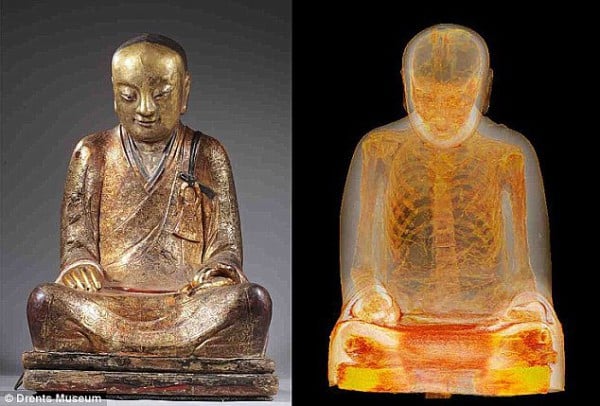Art & Exhibitions
Priceless Stolen Buddha Statue with Mummified Monk Inside Turns Up in Museum Show
Villagers have been worshiping it since the 12th century until it went missing.

Villagers have been worshiping it since the 12th century until it went missing.

Zoe Li

China claims a Buddha statue, which caused a sensation when a mummified monk was discovered inside it, was stolen from Fujian Province two decades ago.
It was recently the centerpiece of an ongoing exhibition at the Hungarian Natural History Museum, until it was pulled out by its owner last Friday, reports the state-run Xinhua news agency.
The Cultural Relic Bureau is currently investigating the ownership of the statue, which was borrowed by the Natural History Museum from the Netherlands’ Drents Museum, where it was part of an exhibition last year.
According to a statement on the Hungarian museum’s website, the statue was removed from the exhibition on March 20 due to a request from Drents.
China claims that the Buddha statue is a relic stolen from Fujian Province’s Yangchun Village. The Cultural Relic Bureau says villagers have been worshiping a similar statue since the 12th century until it went missing from the temple in 1995.
The bureau sent experts to the village and found photos, artifacts, and historical documentation suggesting the mummy was an ancestor of the local clan.
According to the documents, the monk was a local man who gained a reputation for curing diseases and promoting Buddhist principles. He passed away at the age of 37.
A Drents Museum spokesperson told Chinese media that the Buddha statue now belongs to a Dutch private collector who bought it legally in 1996 and who had no idea that a mummified monk was inside of it until he took the statue in for restoration.
The Buddha underwent a CT scan in February as part of its restoration procedure in the Netherlands and the 1,100-year-old remains of a Buddhist master, believed to be named Zhang Liquan, were revealed.
When China’s Cultural Relics Bureau completes its investigation it will likely seek repatriation of the Buddha statue.
China has recently been campaigning for the return of stolen Chinese artifacts surfacing abroad (see China’s Exporters Smuggle Antiquities as Cheap Knockoffs, and Chinese Group Demands Japan Return Looted Artifact). State media expressed outrage when bronze fountainheads pillaged from Beijing’s Summer Palace during the second Opium War were put up for public auction in 2009. The bronzes were eventually returned to China by French billionaire Francois-Henri Pinault.